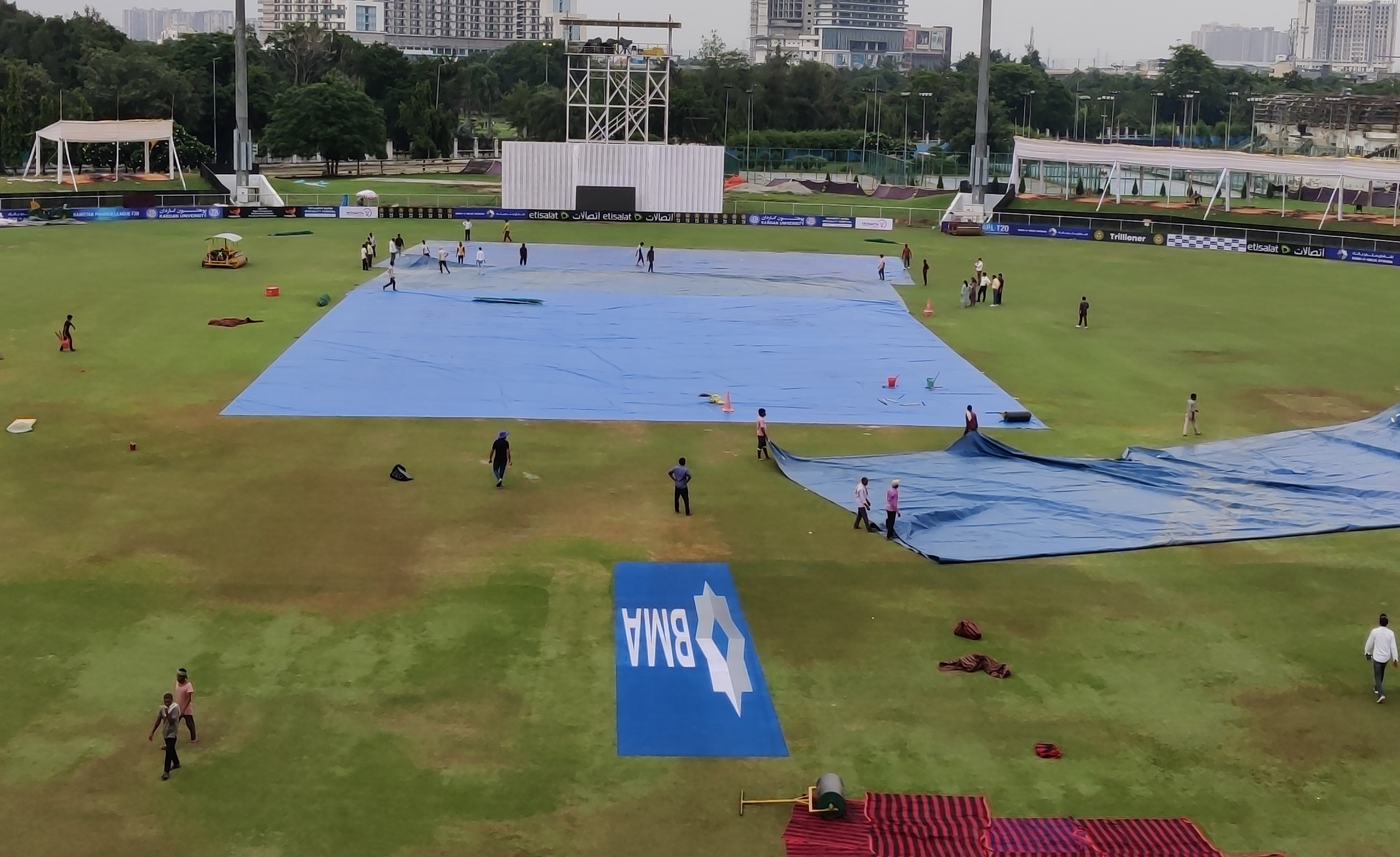Story
Why are both BCCI, Afghanistan Cricket Board responsible for Greater Noida Test mess
11 Sep, 2024
The Shaheed Vijay Singh Pathik Stadium in Greater Noida does not tick all the boxes as per experts and is most ill-prepared for holding a Test match especially in the monsoon season; teams spend time in the hotel as Day 3 of the one-off Test also called off
 Bareera K.H.
Bareera K.H.
A young aspiring cricketer beginning to write
 Khurram Habib
Khurram Habib

The Afghanistan Cricket Board (ACB) was left red-faced after the third day’s play of the one-off Test against New Zealand was called off due to unsuitable playing conditions on the ground. The first two days were also abandoned without a ball bowled due to wet outfield.
“Afghanistan vs New Zealand Day 3 is called off due to persistent rains. The match will commence with 98 overs from tomorrow if the skies get clear,” said a statement from the ACB on Wednesday morning.
The message did one thing – it saved reporters and fans from travelling all the way to Greater Noida from Delhi.
However, it did not hide the fact that the Afghans made a poor choice of venue, one that did not have any facility to withstand rainfall.
The Shaheed Vijay Singh Pathik Stadium, which was reportedly banned by the Board of Control for Cricket in India (BCCI) a few years ago for hosting a questionable private tournament, had been home for ACB in the past before they shifted base to the United Arab Emirates (UAE).
It hosted BCCI’s Duleep Trophy matches with pink ball a decade ago in a grand launch before going out of favour.
Afghanistan, however, picked this ground for this Test due to logistical convenience and cost-effectiveness since UAE, their regular home, would have been searing hot at this time of the year and holding the one-off Test vs New Zealand in Bengaluru and Kanpur – two other options given by BCCI -- was costing them more and involved more travel than the one in Greater Noida. It is still a surprise that BCCI chose to keep Greater Noida as one of the three options even though it has apparently banned it from its own roster.
They had initially wanted Lucknow or Dehradun but both had state leagues (UPT20 League and Uttarakhand T20 League) scheduled at this time.
However, what they failed to do seemingly, is proper recce involving grounds and pitch experts trained in the science.
Although both Akbar Paktian, the Commercial Manager of ACB, and Menhajuddin Raz, the International Cricket Manager of ACB, said that the “checklist was healthy and the recce was fine and it is only the heavy rainfall that caused it”, the fact is that the venue lacks basic modern-day drainage system and does not even have full cover. All this exposes the lack of comprehensive recce.
The Shaheed Vijay Singh Pathik Stadium also does not have a BCCI-trained curator. There is just a head groundsman with limited staff.
It has been learnt that an official from the Delhi and District Cricket Association (DDCA) went all the way to Greater Noida on Tuesday to deliver full cover for the ground, which is clay-based or soil-based and not sand-based like many modern-day grounds. The water gets held up in clay-based grounds and doesn’t infiltrate as quickly as it does in sand-based grounds.
Even the Ferozeshah Kotla ground in Delhi and the Eden Gardens in Kolkata are clay-based. However, they have full covers through which they can cover the entire ground. They also have standard drainage.
The stadium in Greater Noida does not have a full cover and patches were left uncovered. In fact, they were apparently making do with shamiana tent cover which is thin, having a GSM of 90-120 as against the cricket ground covers which are thick, having minimum GSM of 360.
The lack of proper drainage at the venue was also exposed.
Water, even though it didn’t rain during the day-time, got collected at the ground leaving damp patches in the outfield. The outfield looked more like a farmland where vegetables or paddy could be grown.
The ground apparently lacked surface gradient or the slope which, in normal grounds, should be in the ratio of 1:100. It means that every 100 feet on the ground should have a slope of one feet, according to experts. That slope allows water to flow towards the boundary.
“In venues that experience very heavy rainfall, the ratio is 1:90,” said an expert.
That apart, experts say, the drain on the periphery of the ground should be three-feet deep and two to 2.5 feet wide to ensure that the water goes out in large quantity. The pipes or outlets through which water flows out of the stadium from the drain should be two to three in number with each of around 12 inches.
The Greater Noida stadium falls short on all these standards and the ACB, apparently ignorant of all this, went ahead and chose the venue.
What made it worse was the timing of the match. It is a pity that the monsoon that usually finishes by August has been shifting further towards September and there have been unseasonal rainfall too at different parts of the year.
All this should have been taken into account by the ACB.
BCCI, Cricket, Afghanistan, New Zealand, Greater Noida, wet outfield, called off